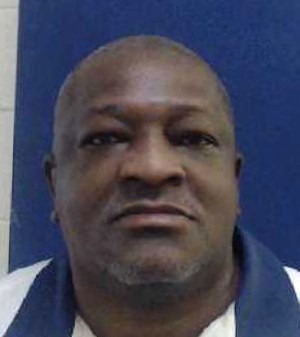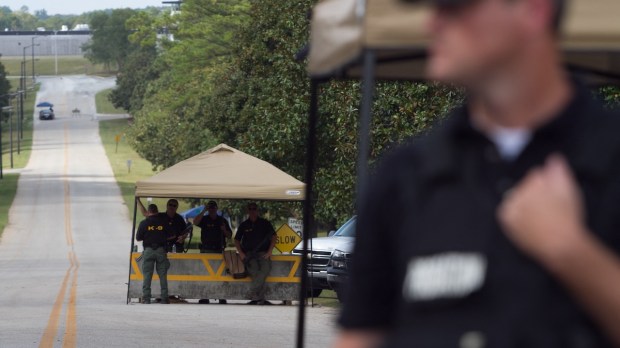“For or against?”
The questions startled me. I didn’t know really how to answer. I didn’t think that anyone coming here actually would be for the execution. I remained silent, as the guard looked over our drivers licenses, made notes on his clipboard, and consulted with other guards.
“Against, right?” he came back at me as he finished up his paperwork and prepared to direct us to the next area.
“Right,” I said, without much conviction.
We came here, to the Georgia Diagnostic and Classification Prison, because our pastor last Saturday evening made an announcement at the end of Mass. The folks who had made a presentation at church in January – Georgians for Alternatives to the Death Penalty – informed him that an execution was scheduled for Wednesday evening at the prison in Jackson and that there would be a vigil outside. Anyone could attend.
Being relatively new to Georgia, we had no idea that (1) the Peach State had a death penalty, and (2) it could be administered right here, so close to where we live.
I thought about it for a few days, the possibility of attending the vigil. I would need to maintain my journalistic neutrality. I wouldn’t go there and take part in any demonstrations, for or against – although, again, I didn’t imagine that anyone would go there and clamor for the prisoner to be executed. It just didn’t occur to me until that guard put the question to us.
But I’d never been to such a thing, and I don’t think our website ever covered something like this in person.
“I know,” I thought: “I’ll go there and shoot some video on my phone and put something together. A video report of the prayer vigil.”
Wednesday morning came, and I was starting to feel more confident about going. I also started to think about Willie Pye, 52, who had been convicted of the 1993 murder of his ex-girlfriend, Alicia Lynn Yarbrough. I knew nothing about the man, but I kept thinking of the fact that this would probably be his last day on earth. What must it feel like to know that you’re going to die tonight? No matter what you think about the death penalty, when you get this close, it’s hard to run from the fact that here is a man, a human being, facing something imminent that all of us will have to face some day – our death. Except that he knows with much more certainty that it will happen on a particular date and a particular time.

We all have a death sentence, in a manner of speaking. We just haven’t been served the warrant yet.
Pye’s name had been in the news for a few days already. A number of people, including Atlanta Archbishop Gregory John Hartmayer, had presented petitions for clemency to the State Board of Pardons and Parole. The board met on Wednesday and turned down the appeal. Those arguing for a commutation pointed out that Pye’s IQ was only 68, that he had been abused as a child, that one of his first court-appointed lawyers was a racist, and that some of the jurors in his trial subsequently said that if they had known certain things that hadn’t come out in trial they never would have voted for the death penalty.
These were details reiterated during the vigil by Mary Catherine Johnson, director of New Hope House, a prison ministry. People were gathering for the vigil behind ropes set up in a grassy area under tall slender pines, just inside the prison complex. We joined them after a bomb-sniffing dog checked out our car. Apparently, another pen was set up for the pro-death penalty side, but I didn’t notice anyone there. Johnson told me later that members of the KKK used to come and fill that space.
She should know. She’s been attending executions for many years. Her prison ministry, which is not far from here, offers support and hospitality to death row inmates and their families.
Our pen was so far from the prison that we couldn’t see the buildings. But we could see official vans going through the front gate and making their way up to the prison: probably family members of the condemned, witnesses, journalists.
Light turnout
My idea of shooting video of the vigil was dashed by a guard who came up to us as we walked from our car to the protest enclosure. He’d seen me already starting to shoot some video of the surroundings, which included a gaggle of guards.
“You’re going to have to leave your phones in the car,” he told me and my wife. We obeyed. What else could we do?
Johnson told us that no one in the small gathering had been allowed to take a phone along either. The guards had never done that before, and she wasn’t sure why the change.
I took a quick glance at some of the other cars. I always look at bumper stickers, and my attention was quickly drawn to a Sonski/Onak sticker – this year’s presidential ticket of the American Solidarity Party. There were an assortment of pro-life and LGBTQ stickers on a variety of vehicles.
Arriving around the same time as us was a self-professed ex-con named Tom who let us and everyone else in earshot know that he’d been to the Pardons and Parole Board hearing yesterday in Atlanta and knew as soon as the board came in the room that they were going to deny. He said he could see hostility in their faces and demeanors.
Tom claimed to have known Pye in prison.
We were welcomed into the enclosure in a very friendly way and thanked for coming out. There couldn’t have been more than 10 people there, including Johnson and Cathy Harmon-Christian, executive director of Georgians for Alternatives to the Death Penalty. The weather was so lovely. The second day of spring, but spring had been making its presence known for some time here, and tonight the temperature and humidity were just right. I could understand how some people might just rather stay home and eat out on the deck, instead of standing outside a state prison. I suppose some people would have similar difficulty choosing to spend Saturday morning at a 40 Days for Life vigil when it’s good beach weather.
Keeping hope alive
My wife wanted to pray the Rosary and Divine Mercy chaplet. I fingered my chotki and intended to pray the Jesus Prayer for the condemned man. But Johnson soon began the vigil, and I wanted to listen to what she had to say.
“We’re here to celebrate Willie Pye, in his humanity,” she began. “As far as we know, he’s still alive, and we’ll keep hope alive until we hear otherwise.”
Pye’s execution would be the first one in four years. Johnson read some testimonials about him, how he had delved deeper and deeper in his faith over the years, how he was adored by a niece, and how he took so much pride in her accomplishments that she was all he could talk about sometimes.
In other words, if the death penalty is meant to protect society from violent criminals, Pye certainly didn’t seem to be one of them.
She had a sheet with the names of every man and woman who had been executed in Georgia since 1976, when the death penalty was restored. She asked that we pass the list around, and that one by one we each read a name. By this time, a number of other people had arrived, including two women Episcopal ministers, but our number was still small, and the list went around at least five times. I was somewhat startled when I heard one name – a man who had the same family name as mine.
On one go-around the woman to my right, who held a sign saying, “We remember Alicia Yarbrough,” almost broke down in tears. The name she just read “was my husband’s best friend,” she said.
It turns out that this woman’s husband was inside this very prison – also on death row.
A woman across the circle from me, who wore a Roman collar and a black outfit with “BLM” printed on her shirt – she later told me that she was from a Unitarian Universalist church in Atlanta – prayed aloud in the name of the whole group. And then the circle sang several verses of “Amazing Grace.”
I noticed other t-shirts, including one that said “Democrats for Life of America,” and another that had “Pro-Life” on the back and an anti-death penalty message on the front.
It was long past seven, the time when Pye was to have been executed. One member of the circle did have a phone with her – she said the guards never told her otherwise – and she was getting messages that Pye’s attorney had filed an appeal to the US Supreme Court. So we waited.
Finally, we told Johnson and Harmon-Christian that we really needed to get home. They understood completely, but they would be there until they got some news, one way or the other. “Sometimes I’ve been here till 2 in the morning,” Johnson told me.
We drove home and prepared dinner, which we ate in a rather somber mood. I kept wondering if I should rewrite the Good Friday meditation that our pastor had asked me to deliver at the Seven Last Words service, somehow working in this experience. I was assigned the penultimate word, “It is finished.”
For Pye, those words took effect at 11:03 that night. The Supreme Court had turned down the appeal. Official witnesses reported that he had declined to make a final statement before the lethal injection was administered. But he accepted that a minister say a final prayer for him.
That wasn’t the only one.




